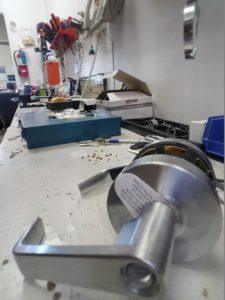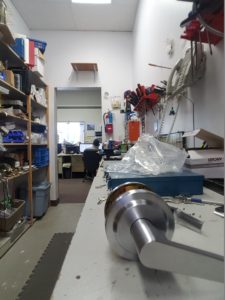Leverage
So when your manager is off for 2 weeks and your sales take up almost all of your time, something suffers. Fortunately for everyone, it’s just a week. And I’ve got stories. So many stories… None of which I can tell here.
What I can tell you is that when one of your most knowledgeable people is off for any amount of time, you notice. And we noticed.
In that time where I had no time for writing, I did have time to come up with ideas for this post. Luckily I woke up this morning and totally blanked on what those ideas were. So. Instead. We’re going random. Just cause.
That’s the great thing about security. You can basically write about whatever topic you want, and still be on topic.
This is a double sided deadbolt. We touched on a few do’s and don’t’ for these in the last post. Most of it was pretty basic stuff.
There’s a lot of basic stuff in locksmithing. Or stuff that seems basic and is actually pretty complicated. Or not so obvious unless you’ve been at it for three decades.
So let’s stay basic. Levers. You know what they are, but you may not know the things they can do.
Entry Function
Your most basic of levers, and the one you’re probably most used to. It has a keyhole on one side;
And a thumb turn or push button on the other;
This lever, and it’s knob style equivalent, is probably the most common cause of lockouts in exterior home doors, basically because you don’t need a key to lock it. These locks are primarily used now for interior doors.
Passage Function
A lever (or knob) with no ability to lock itself. It’s only function is to allow you to open the door, and latch it closed.
These are installed on either doors you don’t want to lock, or in conjunction with a deadbolt which requires a key to lock. It’s much harder to lock yourself out of a home when you need a key to lock the door.
These are most common on most dwelling entry doors, and main entrances that are not glass aluminum.
Privacy Function
These go on your bathroom, or wherever it is you want privacy.
There is still no key on either side, replaced instead by a button and a thumb turn. This allows you to lock the door, while leaving the lock accessible to someone in case of emergency.
Typically these go on individual business or residential bathrooms, or any other area where you want privacy and really aren’t all that concerned that someone is gonna walk in on you.
For the more public bathrooms, there are these;
Storeroom Function
You know what this is, even if you didn’t know what it was called. The design of the storeroom lock was to be always locked from one side, and never locked from the other.
Their main use? Storerooms, surprisingly. They assure you’ll never be locked in the storeroom, while also assuring anyone who isn’t supposed to be inside can get inside unless they stumble on a key. You can’t “forget” to lock a storeroom lock, because the key side is always locked.
Thus their popularity with individual public bathrooms (gas stations, public office buildings, etc), as well as your main solution for automatic door release systems.
The Knobs
The knob equivalents are all available for each of these hardware types. Levers run with a higher price tag, but also add a level of accessibility for those who need easier-to-manipulate hardware. Plus, if you are upgrading hardware to match AODA regulations, levers are an absolute requirement on all buildings.
That’s not all
These are simply the most common types of levers out there. There are other, more specific functions we can talk about if you want to. In fact, at this point, there are very few functions a knob or lever can’t be designed to accommodate.
Lastly, if you’re looking at glass aluminium doors, they are an entirely different specific lock set we can get into later. Or you can call us and let us know what you need.










No comments yet.